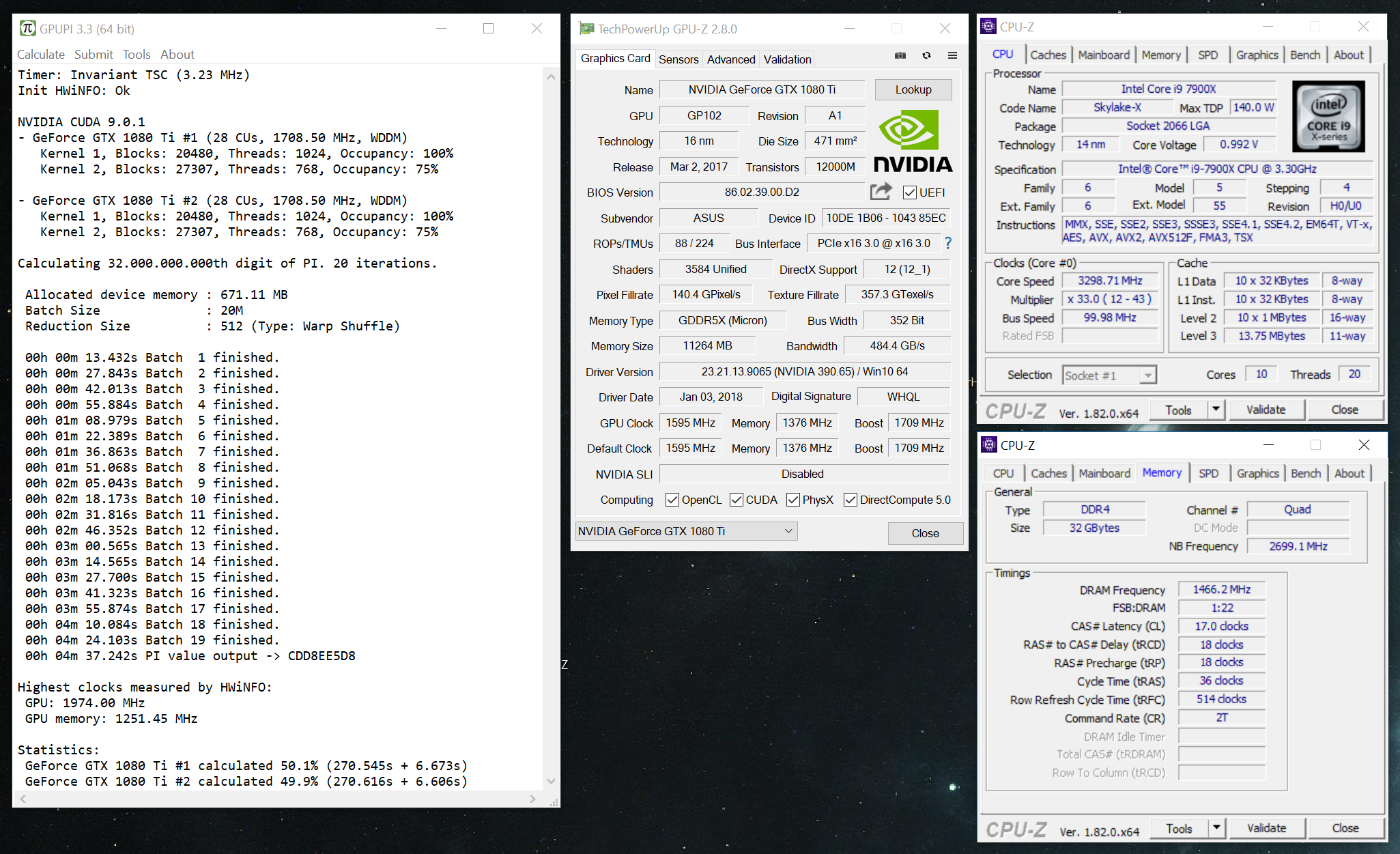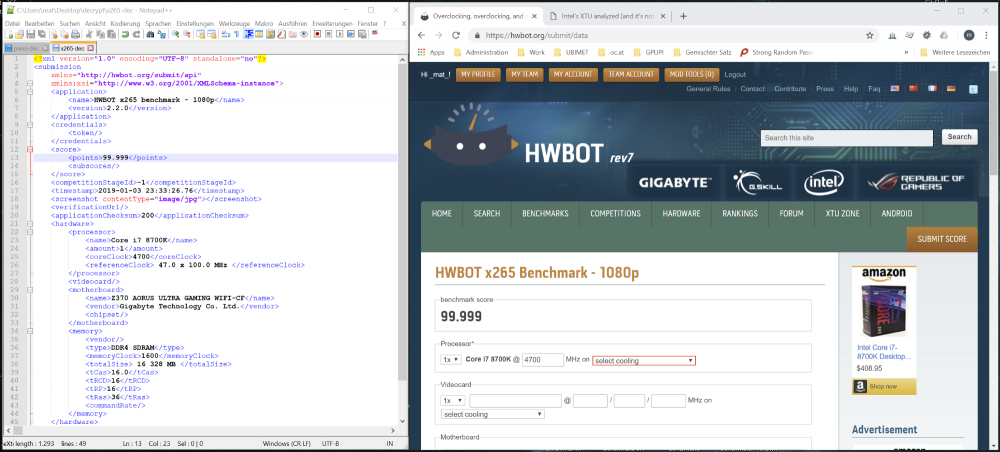-
Posts
1003 -
Joined
-
Last visited
-
Days Won
41
Content Type
Profiles
Forums
Events
Blogs
Posts posted by _mat_
-
-
-
XTU doesn't need AVX, there are code paths inside the inner benchmark executable without AVX as well. You can also disable the AVX path via a configuration file, details in my article here.
-
 1
1
-
-
Seems like the category has to be added manually by the mods to make it work. @Leeghoofd?
-
OpenCL support for CPUs will be deprecated in GPUPI 4 anyway, so this won't be a problem in the long run.
-
 1
1
-
-
Well, I'm not a lawyer.
My personal opinion is to not give a fuck about any of that.
-
AMD has no official links for its APP SDK, that's true. I will upload them to overclockers.at for better availability.
As for Intel OpenCL runtime I have no clue what you are talking about. You are from Germany, right?
Here is the latest Intel OpenCL runtime: https://registrationcenter.intel.com/en/forms/?productid=3207-
 1
1
-
-
Looks good, I like the new responsive design. Some tables (ranking for example) still need some work by either removing unnecessary columns and/or pinning the first column and add the scrollbar to the other columns.
Like this: https://zurb.com/playground/projects/responsive-tables/index.html-
 3
3
-
-
The profile should have been uploaded anyway, right? I am also getting this most of the times with the latest version of XTU and the upload works in the end.
-
9 hours ago, speed.fastest said:
XTU actually is fun to bench, only if it support AMD and not only 2 seconds count for scoring. There is still no successor for SuperPi 32m for new platform, proper multithreaded & memory scales a lot! I only think is 3DMark11 Physics is only option for now to replace SuperPi 32m.
I already have a Prime95 benchmark ready that scales pretty much perfectly and is very hungry for memory bandwidth. It is using the latest Prime95 version (29.4) and includes a few fixes like NUMA awareness, improved thread synronization and error checking. It's also faster than the XTU version.

It seamlessly integrates into XTU so you can start XTU with an AMD CPU and just run the benchmark. It won't be far off to create a WIN32 application that runs the bench and uploads the score to HWBOT. Is this something the community would be interested in?-
 1
1
-
 4
4
-
-
Yes, every benchmark is breakable and nothing is 100% bulletproof. But that's not necessary, we only need to increase the cost for cheating to a level where it's easier/cheaper to just overclock and make the damn score. Overclocking has no 100,000 USD competitions, so it's not an impossible task.
Regarding your benchmark and its current state of security:
It took ~2 hours to break HWBOT Prime 1.0 and your bench and I've never written a single Java desktop application. it. No debugging or code changing involved, only static analysis of your executable. If you need details on how to reproduce this, just let me know and we'll chat.
-
 1
1
-
 1
1
-
-
Now that XTU will have its global points removed soon, I am officially publishing my findings on this benchmark. I tried to give full insight on how to disect and uncover the security issues of XTU but also some tweaks and the possiblity to run the inner benchmark executable on its own for quick performance testing and points calculation.

https://www.overclockers.at/articles/intels-xtu-analyzed
This is not some kind of personal vendetta against Intel; far from it. The article's purpose is purely educational to raise awareness for benchmark security and timer reliability. This is not only about cheating, it's about the credibility of benchmarks and result databases like the bot as well. Security vulnerabilities are not taken seriously enough by benchmark developers and HWBOT in my opinion. Yes, I am going the hard way with XTU in my article of course and that's not for everyone. But there are already tools available for download that will get you ahead without any effort.
So I'd like to start a discussion here on how we can improve the situation permanently. It goes without saying that any serious initiative would require a cooperation from all sides involved.
-
 6
6
-
 7
7
-
-
Yes, it's ok.
-
Congrats Allen! So much research and effort behind this awesome score!
-
Congrats! Is Windows Server 2012 really faster than Windows 10?
-
Holy hell! Are we really benching 8 cores on 7G already? Great score, congrats!
-
Congrats Bruno! Nice find on the new Intel OpenCL driver. It implicitely makes use of AVX512 instructions for the first time, so that gives the nice boost if anybody wonders: https://software.intel.com/en-us/articles/opencl-drivers
PS: The screenshot is a bit unlucky though because the message box hides this information.

-
 1
1
-
 1
1
-
-
Use Windows 7 for old hardware, it will allow RTC because there is no drift possible there. GPUPI follows the rules of HWBOT there.
As for the hardware detection bug on old hardware, I will look into it.
-
Great work! The Taichi seems to be an awesome board.
-
 1
1
-
-
Every bench works differently and therefor has different needs. There is nothing wrong with that.
Knowing the benches, the hardware plus all these extra tricks like the right BIOS version/OS/driver/mod is exactly what overclocking is about. You know, Turrican was not a talkative person but if you asked him something very specific about a bench and a (old) platform he could talk a good while about all these little things, that showed why he really was that good. As I said, nothing wrong with that ...
-
6 hours ago, havli said:
No, but it is not needed for anything but GPUPI... so waste of time in my book. Also the risk of bricking the MB is always there if something goes wrong.
If you really think that then you are on the wrong forum.
PS: I just flashed a FM1 board 20 times. Seems like I'm crazy in the coconut. ?
-
 2
2
-
-
Nice find! This looks exactly like the problem that we have encountered. The only fact that doesn't fit are the PassMark numbers. They are even worse then those in my micro benchmarks for div and modulo.
Well, it might be possible to write a fix that sets the MSR mentioned in the PassMark forum to enable the division unit again. If this were a new CPU generation, I would do it. But for seven year old CPUs this is just overkill.
Btw the article also explains why an old BIOS might not work. Windows could be responsible for disabling the division unit no matter what the BIOS says. So I guess that's why Windows 8 and Windows 10 show no performance advantage with pre AGESA 1.1.0.3 BIOS versions. This might be true for Windows 7 as well when optional updates are installed. I didn't install everything on my test drive, just SP1 and nothing optional.
-
It was never meant to run CPUs in the first place (hence the name), but I'm glad it is used with both.
Yeah, OpenCL is a turn-off to say the least. But that will change soon with GPUPI 4.0. As you can see in the screens the native path is already stable and faster than OpenCL on all platforms. The reason why it's taking longer than anticipated is, that an early release without good SSE and AVX support will end up in the same dilemma as GPUPI 3.3. And I really want that AVX support. ?
-
Voodoo is only at play when there is not enough disclosure. There is always an explanation, start digging.

-
It is possible the OS plays into this as well. Did you try Windows 7?



Tweak book for cheats
in Old HWBOT Rules (pre 2021)
Posted
Can't see anything wrong with it as well. If you find a way to cheat, publish a score and disclose the details in the thread. Mods will have to pick it up from there to make it work, no other way around it. Forcing the bot's hand, so to speak.